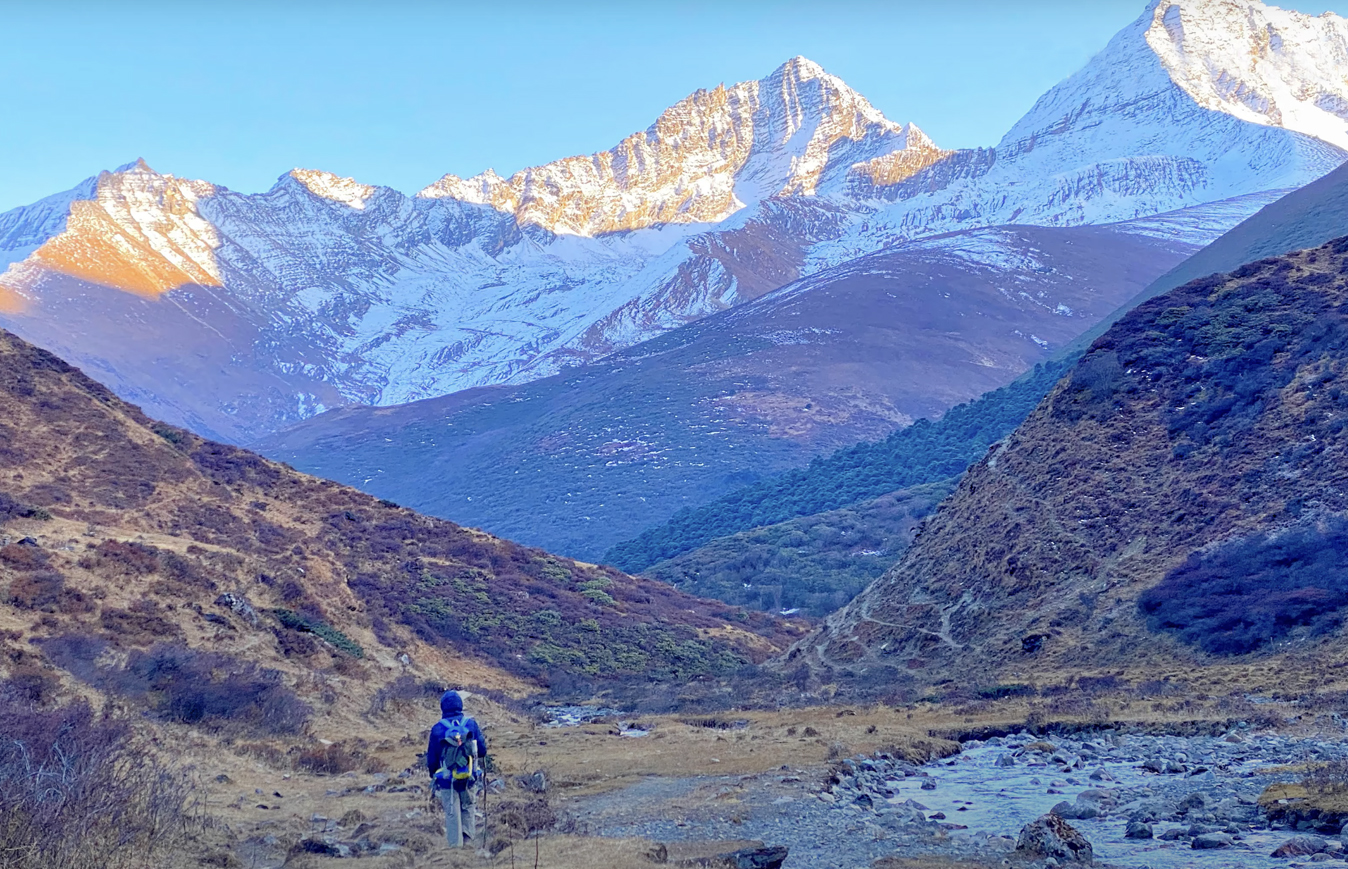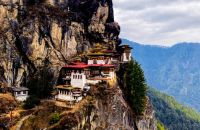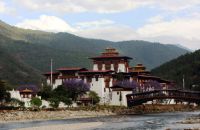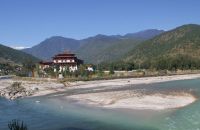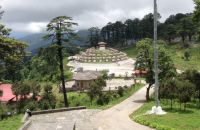Talk with our local travel specialist who can help organize your trip.
How much does it cost to do the Jomolhari Trek, Bhutan?
Bhutan, a mountainous country located high up in the Himalayas, offers a lot of exciting hiking and trekking opportunities. The Jomolhari Trek, which takes trekkers to the base of the sacred Mount Jomolhari, is one of the most popular treks in Bhutan. This high-altitude trek can be completed within a short span of seven days.
The Jomolhari trail offers spectacular views of snow-covered Himalayan mountains like Jomolhari, Jichu Drake, Tsering Gang, Gangchhenta, and Masang Gang. The trail weaves past lush forests of rhododendron, birch, and conifer and emerald glacial lakes filled with brown trouts. The trail takes you inside the Jigme Dorji National Park, which is home to an interesting array of Himalayan wildlife and vegetation.
Table of Content
- How much does it cost to do the Jomolhari Trek, Bhutan?
- What’s included in the Jomolhari Trek cost?
- What is not included in the total trip cost?
- Jomolhari Trek: Overview
- Jomolhari Trek Route
- When is the best time to do the Jomolhari trek?
- Acclimatization
- How difficult is the Jomolhari Trek?
- How to train for the Jomolhari Trek?
- Do you need a special license for the Jomolhari Trek?
- Is it possible to do the Jomolhari Trek solo, without a guide?
- What does a typical day look like on the Jomolhari Trek?
- Food served during the trek
- Toilet and bathroom while camping
- Is it difficult or easy to obtain a visa for Bhutan?
- How to enter Bhutan?
- Bhutanese Currency
- Languages Spoken
- Other popular treks in Bhutan
- How is trekking in Bhutan different from trekking in Nepal?
- Conclusion
How much does it cost to do the Jomolhari Trek, Bhutan?
If you are planning to do the Jomolhari Trek and are wondering about the total cost, then you should know there’s no fixed rate for this trek. Depending on your group size and itinerary, the Jomolhari trek can cost anywhere between USD 5959 and USD 2965.
The cost of the Jomolhari Trek is determined by the total number of trekkers in your group, the kind of accommodation you choose, extra activities, and the cultural sites you will visit. It will cost less per person in a larger group,
What’s included in the Jomolhari Trek cost?
Apart from the trekking cost, trekking agencies include other surcharges like city tour cost, transportation, hotel accommodation, etc. in the total trip cost. Local tour companies may include the following expenses in the total trip cost:
- Bhutan Visa
- Sustainable Development Fee
- Trekking permit and National Park Permit
- Hotel accommodation as per the client’s preference (3-star, 4 stars, or 5-star) in the cities
- Overland transfers
- Local tour guide and trek guide
- Support crew while trekking (cook, helpers, horsemen)
- Ponies or horses to carry heavy luggage
- Group Camping Gear (sleeping tents, dining tent, kitchen tent, mattresses, etc.)
- All meals while trekking
- Entry fees at cultural sites
What is not included in the total trip cost?
The following expenses will not be included in the total trip cost and should be borne by the client:
- International air fares
- Travel Insurance
- Personal expenses (food and drinks that are not paid for by the agency, laundry bills, mobile sim, internet data, etc.)
- Tips
Jomolhari Trek: Overview
The Jomolhari Trek involves walking to the base of Bhutan’s sacred mountain Jomolhari within a short time. The high-altitude trail to Jomolhari is one of the most beautiful trekking trails in the Bhutan Himalayas. Within a short span of time, you will be able to walk close to the foothills of 7000 and 6000-meter peaks. The views of glaciers, snowy mountains, lakes, and windswept glacial valleys along the trail are stunning and captivating. The trail enters Jigme Dorji National Park and follows uninhabited stretches of virgin forests and yak pastures. The gurgling Paro River and Thimphu River are never far from the trail.
The Jomolhari trekking trail weaves past lush forests of pine, cedar, and fir and alpine meadows carpeted with soft green grass and wildflowers. Herds of yaks and Himalayan Blue Sheep graze peacefully in the alpine pastures, while flocks of Himalayan Griffons can be seen flying majestically in the sky.
The trail takes you past tiny villages with very few houses. Thangthangka, Soe, Doongochang, and Lingzhi (one of the highest villages in Bhutan) are some of the villages that lie on the Jomolhari trail. The route is peppered with white chortens, prayer flags, and ancient ruins of palaces and fortresses.
Overnight stays will be at yak herders camp and open pastures offering mesmerizing views of the snow-covered Jomolhari and Jichu Drake. Added in the itinerary are visits to Bhutan’s iconic cultural gems like the Tiger’s Nest, Buddha Dordenma, and Paro Dzong.
The major highlights of this trek are close-up views of Jomolhari, Jichu Drake, and other 7000-meter peaks, fascinating wildlife encounters with Himalayan blue sheep, wild yaks, and Himalayan marmots, and a diverse Himalayan scenery (from lush green forests to barren high-altitude desert scenery). Excursion to Tshopu Lake or Twin Lake is also one of the highlights of this trek.
Featured Trips
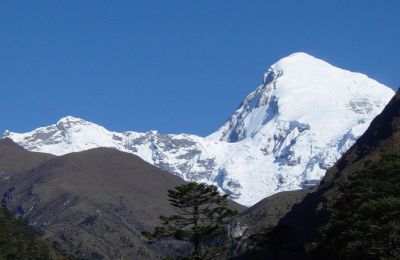
Jomolhari Trek - 11 days
Jomolhari Trek offers a taste of the great variety of Bhutanese landscapes and the most enchanting adventure trek in Bhutan. Jomolhari is the second-highest unclimbed mountain in Bhutan.
Inquire NowWhere to travel next?
Get help from our travel specialists for holiday ideas that matches your interests.
Jomolhari Trek Route
The Jomolhari Trek has two routes, and you can follow the one that best suits your interests.
Short Route: Jomolhari Loop (Paro—Jomolhari Base Camp—Paro)
This is a much shorter route and takes around five or six days to complete. It usually starts from Shana in Paro, goes up to the Jangothang or Jomolhari Base Camp, and ends in Shana. The itinerary may be longer with the added days for cultural tours in the cities.
Long Route: Jomolhari Trek (Paro—Jomolhari Base Camp—Thimphu)
The longer route starts from Shana in Paro, weaves across the base of the Jomolhari Peak, and continues onto the high mountain passes and forested hills of Thimphu. En route, there will be crossings over Nyeli La and Yeli La, high mountain passes with stunning views. The ending point of this route is Dodena or Drugyel Dzong in Thimphu. It takes around seven to ten days to walk across this route.
There are no lodges or teahouses on the way, so the team will be camping out in tented camps or at the summer huts of the nomadic yak herders. All food and camping equipment will be arranged by the trekking agency. You will have a local guide with you and a local crew who will take care of meals and set up tents. Horses or mules will be used to carry the heavy luggage and camping equipment. The weight of your personal luggage should not be more than 15 kg.
When is the best time to do the Jomolhari trek?
September to November and March to May are considered to be the best months to trek in Bhutan, as the weather generally remains stable during these months. There is less precipitation, and the days remain warm and sunny. While the trail is open year-round, heavy snow during the winter and landslides during the summer or monsoon season may lead to the trail’s closure. So it’s better not to take to the trails during the off-season.
Even during peak season, one should be prepared to face rough weather (sudden rainfall, thunderstorms, and icy trails), as the weather in Bhutan is unpredictable. While trekking, rain gear, mudguards, crampons, or microspikes should always be in your bag regardless of the season.
Acclimatization
Since this is a high-altitude trek, acclimatization is really important. Before the start of your trek, you will spend a day or two in Paro hiking and acclimatizing.
It is important to let your body adapt to the change in elevation before heading up to higher elevations. While on the trail, you should be mindful of keeping your body hydrated by drinking water or hot fluids constantly. Do not forget to pack Diamox (medicine for altitude sickness) while packing for your trek. Ginger tea and garlic soup are also effective in reducing the symptoms of AMS, or acute mountain sickness.
How difficult is the Jomolhari Trek?
This is a trek of moderate difficulty. Since the Jomolhari Trek involves crossings over high-altitude mountain passes, you need to have prior experience in Himalayan trekking. The trail is walkable and doesn’t need technical climbing. However, low levels of oxygen and mountainous terrain make this trek difficult. It also gets pretty windy and cold after midday, which makes one feel uncomfortable. The Yelila Pass, at 4930 meters above sea level, is the highest point of the trek.
How to train for the Jomolhari Trek?
The Jomolhari Trek is a high-altitude trek that takes you to elevations above 4000 meters. Along the way, you will have to cross high mountain passes that are almost 5000 meters. It’s important to train your body to face the challenges at high altitudes before your trek, as not doing so will put you at high risk of suffering from AMS and injuries.
Above 2500 meters, the air pressure and oxygen level decrease, and breathing becomes difficult. The mountainous terrain also makes walking difficult. While technical climbing is not required, you should have the stamina and strength to walk long hours each day.
Physical Exercise
In order to achieve the physical fitness required for the Jomolhari Trek, you need to start training at least three months prior to your trek. Your physical fitness training regimen should include high-intensity cardio exercises like jogging, cycling, and swimming that will build up your stamina.
Take long hikes on the hills that have some steep ascents and descents. You can also climb stairs if there are no hills close to where you live. Build up your muscle strength by lifting weights. Your body’s flexibility and balance can be enhanced by performing exercises like lunges, deep squats, push-ups and pull-ups, Yoga meditation and pranayama (controlled breathing exercise) will help you build up your mental strength and lung power.
Healthy Diet
Also, try to take a balanced diet while training for your trek. A balanced diet rich in nutrients is important to boost your immunity and keep you away from sickness while walking across the difficult terrain. Include lots of fresh fruit, vegetables, dairy, and animal protein in your diet. Snack on granola or protein bars and take vitamin C and D supplements (to ward off cough and common cold) while on the trail.
Do you need a special license for the Jomolhari Trek?
Yes, you do need a trekking permit, which the trekking agency will arrange for you. Since it’s not possible to trek alone in Bhutan, you will need a guide and a trekking crew with you while trekking along the Jomolhari trail.
Featured Trips

Laya Gasa Trek - 17 days
Laya Gasa Trek is an amazing experience in the rural setting in the Land of Thunder Dragon; Bhutan. The 17-day Laya Gasa Trek itinerary is a package combining an experience with Bhutan's nature and culture.
Inquire Now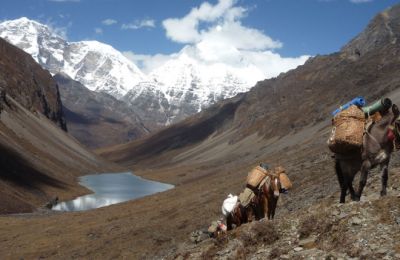
Soi Yaksa Trek - 12 days
Soi Yaksa Trek discovers the transcendental valley of Soi Yaksa nestled in between the hills and mountains of mystic Bhutan. This trek also involved the most biologically diverse environments in the world
Inquire NowWhere to travel next?
Get help from our travel specialists for holiday ideas that matches your interests.
Is it possible to do the Jomolhari Trek solo, without a guide?
No, solo or independent trekking by tourists is strictly prohibited in Bhutan. You will have to book your Jomolhari trek with a licensed trekking agency, which will arrange the permit and logistics of your trek. Since the trekking trail passes through wild and uninhabited areas, it’s advisable to always trek with local guides and crew.
Packing List
For the Jomolhari Trek, you will need to include the following items in your packing list.
Clothing:
- Woolen cap or fleece cap
- sun hat
- Woolen scarf or balaclava
- Trekking pants, sweat absorbent t-shirts, shirt
- Fleece jacket, down jacket
- Quick drying towel
- Sufficient pair of warm socks
- Sleeping bag
- Inner thermals
Footwear:
- Hiking boots that are durable, light, and have good traction
- Mudguard
- Sandals or clothes to wear at the camp
- Microspikes
Accessories and other essential items:
- Waterproof rain gear
- Sunglasses
- Hand sanitizer
- Sunscreen lotion, moisturizer, and lip balm
- Toilet paper, tissues, and wet wipes
- Water bottle with inbuilt filtration system or water purification pills
- Insect repellent spray or lotion
- Snacks (protein bars, trail mix, chocolate, etc.)
- Power bank, batteries for your phone
- Headlight or torch
- Trekking poles
- Essential medicines (Diamox, paracetamol, throat lozenges, ointment for cuts and wounds, painkillers, antibiotics, bandages, etc.)
- Ziploc bags or waterproof bags to store your phone and electronic gadgets
- A plastic bag to store dirty clothes
What does a typical day look like on the Jomolhari Trek?
You will be woken up at around 7 AM by one of the kitchen helpers with a bed tea. Later, a basin of warm water is provided to brush your teeth and wash your face. After freshening up, you will then enjoy breakfast with the rest of the team at the dining tent. You can pack up and get ready for the day’s trek after breakfast. You will set off with the guide while the rest of the crew will dismantle the tents, pack up, and later clean up the campsite. They will load the stuff on the ponies or yaks and continue towards the lunch stop.
You can walk at your own speed, enjoy the scenery, and take pictures. Your guide or one of the helpers will always be close to you, so there’s no fear of losing your way. After two or three hours of trekking, the team will stop for lunch at a meadow or a place with a good view. After eating and resting for a while, you will continue your trek and head towards your destination.
You shall arrive at your destination by late afternoon or evening. The local crew will already be at the campsite pitching the tents and preparing dinner. You will be greeted at the campsite with a hot beverage and cookies. You can spend the evening sitting outside and enjoying the wondrous views of the hills and mountains. At around 6 or 7 PM, dinner will be served. After dinner, you can spend some time chatting or playing card games with the other members or retire for the night.
For sleeping, you will get either a single tent or a two-man tent, which you will share with another person. Mat and foam mattresses will be provided. You can use either your own sleeping bag or the one provided by the agency. To keep you warm over the night a hot water bottle will be supplied. You can store your personal belongings inside your tent.
Food served during the trek
While on the trail, you will be served three big meals: breakfast, lunch, and dinner. A light snack (biscuits, cookies) and tea or coffee will be served at the end of the day’s trek, when you reach the campsite. Items for breakfast will include muesli or porridge, cornflakes, toast, eggs, Tibetan bread, chappati or puri (Indian flat bread) with curry, etc. Coffee, hot chocolate, tea, or juice will be served as per your preference.
Lunch will be packed and served midway from the day’s destination. The local crew will choose a place where you will be able to sit peacefully and have your picnic lunch. Items for lunch usually include rice with mixed vegetables or meat curry, mushrooms, fried rice, noodles, etc.
After reaching the camp, you will be served with a hot cup of tea, coffee, or hot chocolate with popcorn, crackers, or cookies.
Dinner is more elaborate and is a three-course meal. Before the main meal, you can enjoy a piping hot bowl of soup. For the main course, you can expect boiled rice, dumplings, noodles, and a curry of mixed vegetables or meat items. Dessert, which could be a fruit cocktail, Indian sweets, or fresh fruit, will be served after the main course.
Toilet and bathroom while camping
The crew carries a toilet tent and a bathroom tent, which can be easily set up at the camp site. These temporary toilet and bathroom tents are spacious and provide full privacy.
Is it difficult or easy to obtain a visa for Bhutan?
It’s pretty easy to obtain a visa for Bhutan, provided you fulfill the requirements to get a visa. You can get the Bhutan visa online. You can log in and obtain your visa by filling out the form and submitting the required documents. To receive the visa, you will need to pay a visa fee of USD 40(non-refundable) and the total sustainable development fee. The agency you book your trip with can also get the visa for you.
How to enter Bhutan?
You can enter Bhutan by flight or by any of its open land border entry points. There are very few international hubs from where you can catch a direct flight to Bhutan. Only two airlines are allowed to operate intentional flights in Bhutan. You can get your Bhutan flight ticket from either Bhutan Airlines or Druk Air.
If you are planning your trip during the tourist season, it is advisable to book your flight tickets well in advance. Since there are only two airlines operating international flights, the seats will fill up quickly during peak season. Nepal, India, Thailand, Singapore, and Bangladesh are the only countries from where you can catch a direct flight to Bhutan.
To enter Bhutan by land, you will have to choose any of the border entry and exit points that Bhutan shares with India. One option is to enter through the Jaigaon-Phuentsholing border. Gelephu, Samtse, and Samdrup Jongkhar are the other land entry and exit points in Bhutan. Bhutan shares its land borders with the Indian states of Assam, West Bengal, Sikkim, and Arunachal Pradesh.
Bhutanese Currency
Bhutan’s currency, the Ngultrum, is equivalent to the Indian rupee in terms of value. The Indian rupee is widely accepted, while hotels and large shops also accept US dollars. As of September 2024, the approximate value of 1 USD equals to 84 Bhutanese Ngultrum.
There are ATM kiosks in all major cities and towns from where you can withdraw local currency. Visa and Mastercards are widely accepted at ATMs. Please note there might be a cap on daily withdrawals and you will only be able to withdraw a specific amount per day from the ATMs in Bhutan. There are also money exchange centers where you can exchange your currency for local currency. When visiting remote areas, it’s best to carry cash in local currency. You won’t be needing any cash while trekking as there are no shops or restaurants along the trail.
Languages Spoken
Dzonkha is the official language of Bhutan. But a wide number of Bhutanese people also speak and understand English, Hindi, and Nepali. You won’t face communication problems in Bhutan, as tourist service providers like trekking guides, hotel staff, and shop owners can speak and communicate in English. Their proficiency level may be basic and not that high, but you will be able to communicate with them.
Other popular treks in Bhutan
Bhutan, covered by mountains and hills, offers hiking and trekking trails for all levels of hikers. From short- and easy-day hikes to long and strenuous multiday treks, there’s a walking trail in Bhutan for everybody.
Some of the trails for easy day hikes lie in Paro, Thimphu, and Punakha and can be completed within a few hours.
The longer multi-day treks can be physically strenuous and take you across the base of high mountains and mountain passes. Besides the Jomolhari trek, the other popular treks in Bhutan are the Druk Path Trek, Snowman Trek, Dagala Thousand Lakes Trek, Soi Yaksa Trek, Laya Gasa Trek, etc.
How is trekking in Bhutan different from trekking in Nepal?
When you trek in Bhutan, you will get to experience real wilderness trekking. The trails are secluded and far from human habitation. The trekking trails in Bhutan weave past isolated stretches of wild forests and foothills of mountains. With no modern amenities like lodges, shops, electricity, or internet, you will be able to truly experience nature in the raw and enjoy a digital detox.
In Nepal, the trekking trails weave past small mountain villages that have facilities for tourists like lodges, teahouses, or homestays. In most of the trails, you will find shops and teahouses en route. The lodges and teahouses have electricity and an internet connection, which makes the trekking experience easier and more comfortable. The trekking trails weave past the foothills of some of the highest mountains and diverse terrain. While some regions have barred solo trekking, one can enjoy independent trekking at most of the major trekking trails (Everest Base Camp trail and Annapurna trails). While trekking in Nepal, you will also get to enjoy an immersive cultural experience at mountain villages inhabited by Indigenous mountain communities
Conclusion
While trekking in Bhutan may be a costly affair, the experience can be enriching and well worth the money spent. The trekking trails in Bhutan, including the Jomolhari trail, are pristine and untouched by human interference. Therefore, one can savor an authentic wilderness experience while trekking in
Bhutan. Less crowded and less commercialized Bhutan is the perfect place for those seeking to connect with nature and enjoy a soothing and tranquil holiday experience.
The Jomalhari Trek offers one a perfect opportunity to experience a high-altitude Himalayan trek without the usual crowd of backpacking tourists. You will get to walk close to glaciers and soaring snow-clad mountains and enjoy the raw beauty of the mountains, lakes, and glacial valleys.
No matter the cost, trekking in Bhutan is an unforgettable adventure, a once-in-a-lifetime experience.
- Written by: Naba Raj Amgai
Updated: Sep, 17, 2024

